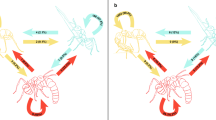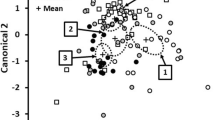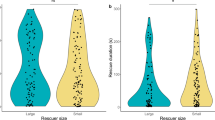Abstract
Division of labor is one of the main reasons for the success of social insects. Worker polymorphism, age polyethism and work division in more primitive ants, such as the ponerines, remain mostly unexplored. The group hunting, termite-specialist Megaponera analis conducts raids in column formations of 200–500 ants. Since these ants specialize on a defensive prey, adaptations to reduce their foraging costs can be expected. We found that the work division, task allocation and column formation during the hunt were much more sophisticated than was previously thought. The column-formation was remarkably stable, with the same ants resuming similar positions in subsequent raids and front ants even returning to their positions if displaced in the same raid, suggesting yet unknown regulatory mechanisms for the formation of the column. We identified three previously undescribed tasks during the hunting process of M. analis: lingerers, runners and raid-guards. Most of these tasks were not executed by predetermined members of the raid but were filled out as need arose during the hunt, with a clear preference for larger ants to conduct most tasks. The plasticity of task allocation was particularly well exemplified by the termite carriers, with the number of small ants carrying termites only starting to rise when less large ants were available. We, therefore, propose that the continuous allometric size polymorphism in M. analis allows for greater flexibility in task allocation, necessary due to the unpredictability of task requirements in an irregular system such as hunting termites in groups.




Similar content being viewed by others
References
Anderson C, Boomsma JJ, Bartholdi JJ (2002) Task partitioning in insect societies: bucket brigades. Insect Soc 49:171–180
Bayliss J, Fielding A (2002) Termitophagous foraging by Pachycondyla analis (Formicidae, Ponerinae) in a Tanzanian coastal dry forest. Sociobiology 39:103–122
Bonabeau E, Theraulaz G, Deneubourg JL (1998) Fixed response thresholds and the regulation of division of labor in insect societies. Bull Math Biol 60:753–807
Breed MD, Harrison JM (1988) Worker size, ovary development and division of labor in the giant tropical ant, Paraponera clavata (Hymenoptera, Formicidae). J Kansas Entomol Soc 61:285–291
Corbara B, Dejean A (2000) Adaptive behavioral flexibility of the ant Pachycondyla analis (=Megaponera foetens) (Formicidae: Ponerinae) during prey capture. Sociobiology 36:465–483
Crewe RM, Peeters CP, Villet M (1984) Frequency distribution of worker sizes in Megaponera foetens (Fabricius). S Afr J Zool 19:247–248
Dejean A, Feneron R (1996) Polymorphism and oligogyny in the ponerine ant Centromyrmex bequaerti (Formicidae: Ponerinae). Insect Soc 43:87–99. doi:10.1007/Bf01253959
Frank ET, Linsenmair KE (2017) Individual versus collective decision making: optimal foraging in the grouphunting termite specialist Megaponera analis. Anim Behav 130:27–35
Frank ET, Schmitt T, Hovestadt T, Mitesser O, Stiegler J (2017) Saving the injured: rescue behavior in the termite hunting ant Megaponera analis. Sci Adv 3:e1602187. doi:10.1126/sciadv.1602187
Gordon DM (2016) From division of labor to the collective behavior of social insects. Behav Ecol Sociobiol 70:1101–1108
Herb BR, Wolschin F, Hansen K, Aryee MJ, Langmead B, Irizarry R, Amdam GV, Feinberg AP (2012) Reversible switching between epigenetic states in honeybee behavioral subcastes. Nat Neurosci 15:1371–1373
Hölldobler B, Traniello JFA (1980) The pygidial gland and chemical recruitment communication in Pachycondyla (=Termitopone) laevigata. J Chem Ecol 6:883–893. doi:10.1007/Bf00990472
Hölldobler B, Wilson EO (1990) The ants. Belknap Press of Harvard University Press, Cambridge
Hölldobler B, Wilson EO (2008) The superorganism. W.W. Norton & Company, New York
Hölldobler B, Braun U, Gronenberg W, Kirchner WH, Peeters C (1994) Trail communication in the ant Megaponera foetens (Fabr.) (Formicidae, Ponerinae). J Insect Physiol 40:585–593
Jeanne RL (2016) Division of labor is not a process or a misleading concept. Behav Ecol Sociobiol. doi:10.1007/s00265-016-2146-7
Kaspari M, Weiser MD (1999) The size-grain hypothesis and interspecific scaling in ants. Funct Ecol 13:530–538
Konaté S, Kampmann D (2010) Biodiversity atlas of West Africa, Volume 3: Côte d’Ivoire. BIOTA 2010. Abidjan/Frankfurt am Main
Korczyńska J, Szczuka A, Symonowicz B, Wnuk A, Anna GS, Mazurkiewicz PJ, Studnicki M, Godzińska EJ (2014) The effects of age and past and present behavioral specialization on behavior of workers of the red wood ant Formica Polyctena Först. during nestmate reunion tests. Behav Processes 107:29–41
Liebig J, Peeters C, Hölldobler B (1999) Worker policing limits the number of reproductives in a ponerine ant. Proc R Soc Lond B 266:1865–1870
Longhurst C, Howse PE (1979) Foraging, recruitment and emigration in Megaponera foetens (Fab.) (Hymenoptera: Formicidae) from the Nigerian Guinea Savanna. Insect Soc 26:204–215. doi:10.1007/bf02223798
Longhurst C, Johnson RA, Wood TG (1978) Termite predation by Megaponera foetens (Fabr) (Hymenoptera–Formicidae) on termites in Nigerian southern Guinea savanna. Oecologia 32:101–107. doi:10.1007/Bf00344694
Naug D (2016) From division of labor to collective behavior: behavioral analyses at different levels. Behav Ecol Sociobiol. doi:10.1007/s00265-016-2092-4
R Core Team (2013) R: a language and environment for statistical computing. R Foundation for Statistical Computing, Vienna
Reyes JL, Fernández Haeger J (1999) Sequential co-operative load transport in the seed-harvesting ant Messor barbarus. Ins Soc 46:119–125
Robinson EJH, Feinerman O, Franks NR (2009) Flexible task allocation and the organization of work in ants. Proc Biol Sci 276:4373–4380
Schmidt CA, Shattuck SO (2014) The higher classification of the ant subfamily Ponerinae (Hymenoptera: Formicidae), with a review of ponerine ecology and behaviour. Zootaxa 3817:1–242
Villet MH (1990) Division-of-labor in the matabele ant Megaponera foetens (Fabr) (Hymenoptera-Formicidae). Ethol Ecol Evol 2:397–417
Wickham H (2009) ggplot2: elegant graphics for data analysis. Springer, New York
Wilson EO (1980) Caste and division of labor in leaf-cutter ants (Hymenoptera, Formicidae, Atta). 1. The overall pattern in Atta sexdens. Behav Ecol Sociobiol 7:143–156. doi:10.1007/Bf00299520
Wilson EO (1984) The relation between caste ratios and division of labor in the ant genus pheidole (Hymenoptera, Formicidae). Behav Ecol Sociobiol 16:89–98. doi:10.1007/Bf00293108
Yusuf AA, Crewe RM, Pirk CWW (2013) An effective method for maintaining the African termite-raiding ant Pachycondyla analis in the laboratory. Afr Entomol 21:132–136
Yusuf AA, Gordon I, Crewe RM, Pirk CWW (2014) Prey choice and raiding behaviour of the Ponerine ant Pachycondyla analis (Hymenoptera: Formicidae). J Nat Hist 48:345–358. doi:10.1080/00222933.2013.791931
Acknowledgements
We thank V. Frank and B. Fiala for critical discussions and reading the manuscript. We thank E. Neugebauer and J. Schäfer for helping collect data in the field. We thank the Comoé National Park Research Station for the use of their facilities and park management OIPR for facilitating field research in the park. E.T.F. was supported by a Grant of the German Excellence Initiative to the Graduate School of Life Sciences, University of Würzburg.
Author information
Authors and Affiliations
Contributions
ETF and KEL designed the study. ETF collected and analyzed the data and wrote the paper. Both authors discussed the results and commented on the manuscript.
Corresponding author
Electronic supplementary material
Below is the link to the electronic supplementary material.
Supplementary material 2 (M4 V 20453 kb)
Rights and permissions
About this article
Cite this article
Frank, E.T., Linsenmair, K.E. Flexible task allocation and raid organization in the termite-hunting ant Megaponera analis . Insect. Soc. 64, 579–589 (2017). https://doi.org/10.1007/s00040-017-0579-2
Received:
Revised:
Accepted:
Published:
Issue Date:
DOI: https://doi.org/10.1007/s00040-017-0579-2




